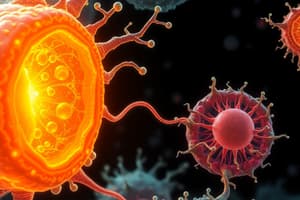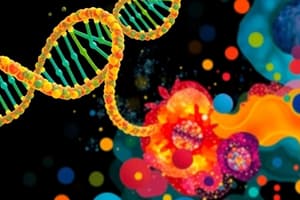Podcast
Questions and Answers
Who is credited with being the first person to observe and describe microorganisms accurately?
Who is credited with being the first person to observe and describe microorganisms accurately?
- Francesco Redi
- Antony van Leeuwenhoek (correct)
- Pasteur
- Hooke
What is the term for the idea that living organisms can develop from nonliving or decomposing matter?
What is the term for the idea that living organisms can develop from nonliving or decomposing matter?
- Cellular Reproduction
- Microbial Growth
- Spontaneous Generation (correct)
- Spontaneous Evolution
What is the primary reason that Koch's postulates are difficult to apply to diseases unique to humans?
What is the primary reason that Koch's postulates are difficult to apply to diseases unique to humans?
- The lack of animal models to test the microbe's causality (correct)
- The high cost of laboratory equipment required to perform the tests
- The difficulty in isolating the microbe from the human host
- The limited understanding of the human immune system
What is the primary tool used to study microorganisms?
What is the primary tool used to study microorganisms?
Who is credited with disproving the theory of Spontaneous Generation?
Who is credited with disproving the theory of Spontaneous Generation?
What is the term for the study of microorganisms?
What is the term for the study of microorganisms?
Which domain of microorganisms is characterized by the presence of peptidoglycan in their cell walls?
Which domain of microorganisms is characterized by the presence of peptidoglycan in their cell walls?
What is a characteristic feature of eukaryotic cells?
What is a characteristic feature of eukaryotic cells?
What is the primary basis for the three-domain system of classification?
What is the primary basis for the three-domain system of classification?
Which of the following is a characteristic of viruses?
Which of the following is a characteristic of viruses?
What is the primary function of Cyanobacteria?
What is the primary function of Cyanobacteria?
What is the term for the study of the origin and history of microbial life?
What is the term for the study of the origin and history of microbial life?
What is the term for the smallest of all microbes?
What is the term for the smallest of all microbes?
What is the term for infectious agents composed of RNA?
What is the term for infectious agents composed of RNA?
What is the primary characteristic that defines life?
What is the primary characteristic that defines life?
What is the primary function of ribozymes?
What is the primary function of ribozymes?
What is the primary source of energy for early life forms?
What is the primary source of energy for early life forms?
What is the primary method used to construct a universal phylogenetic tree?
What is the primary method used to construct a universal phylogenetic tree?
What is the primary characteristic that distinguishes microbial species from microbial strains?
What is the primary characteristic that distinguishes microbial species from microbial strains?
What is the primary function of the RNA world hypothesis?
What is the primary function of the RNA world hypothesis?
What is the primary characteristic of LUCA?
What is the primary characteristic of LUCA?
What is the primary characteristic of a stromatolite?
What is the primary characteristic of a stromatolite?
What is the primary mechanism by which bacteria and archaea increase their genetic pool?
What is the primary mechanism by which bacteria and archaea increase their genetic pool?
What is the primary function of adenosine 5’ triphosphate (ATP)?
What is the primary function of adenosine 5’ triphosphate (ATP)?
Flashcards are hidden until you start studying
Study Notes
Definition of Life
- Cells and organization are essential characteristics of life
- Response to environmental changes, growth, and development are key features of life
- Biological evolution, energy use, and metabolism are fundamental aspects of life
- Regulation and homeostasis are critical for maintaining life
Origins of Life
- Microbial fossils, such as Swartkoppie chert, date back to 3.5 billion years ago
- Fossil record is sparse, and indirect evidence is used to study origins of life
- Scientific method is employed to understand the origins of life
Earliest Molecules - RNA
- RNA was the original molecule that fulfilled protein and hereditary functions
- Ribozymes are RNA molecules that form peptide bonds and perform cellular work and replication
- Earliest cells may have been RNA surrounded by liposomes
Earliest Metabolism
- Early energy sources were inorganic, such as FeS, under harsh conditions
- Photosynthesis evolved 2.5 billion years ago, with cyanobacteria playing a crucial role
- Stromatolites are mineralized layers of microorganisms
Evolution of 3 Domains of Life
- Universal phylogenetic tree is based on comparisons of small subunit rRNA (SSU rRNA)
- Aligned rRNA sequences from diverse organisms are compared to derive evolutionary distance
- Relatedness, but not time of divergence, is determined through this method
Last Universal Common Ancestor (LUCA)
- The root or origin of modern life is on the bacterial branch, but nature is still controversial
- Archaea and Eukarya evolved independently of Bacteria
- Archaea and Eukarya diverged from a common ancestry
Endosymbiotic Hypothesis
- Origin of mitochondria, chloroplasts, and hydrogenosomes from endosymbionts
- Mitochondria and chloroplasts have SSU rRNA genes showing bacterial lineage
- Genome sequences of mitochondria and chloroplasts are closely related to Rickettsia and Prochloron, respectively
Evolution of Cellular Microbes
- Mutation of genetic material led to selected traits
- New genes and genotypes evolved through horizontal gene transfer within the same generation
Microbial Species
- Eukaryotic microbes fit the definition of reproducing isolated populations
- Bacteria and Archaea do not reproduce sexually and are referred to as strains
- A strain consists of descendants of a single, pure microbial culture
Microbiology and Its Origins
- Microbiology is the study of microorganisms
- Tools used for the study include microscopes, culture techniques, molecular genetics, and genomics
Classification Schemes
- Three-domain system divides microorganisms into Bacteria, Archaea, and Eukarya
- This system is based on a comparison of ribosomal RNA genes
Domain Bacteria
- Usually single-celled, with a majority having cell walls with peptidoglycan
- Most lack a membrane-bound nucleus
- Ubiquitous, with some living in extreme environments
- Cyanobacteria produce significant amounts of oxygen
Domain Archaea
- Distinguished from Bacteria by unique rRNA gene sequences
- Lack peptidoglycan in cell walls
- Have unique membrane lipids
- Some have unusual metabolic characteristics
- Many live in extreme environments
Domain Eukarya - Eukaryotic
- Protists are generally larger than Bacteria and Archaea
- Algae are photosynthetic
- Protozoa may be motile, "hunters, grazers"
- Slime molds have two life cycle stages
- Water molds cause devastating diseases in plants
- Fungi include yeast (unicellular) and mold (multicellular)
Acellular Infectious Agents
- Viruses are the smallest of all microbes, requiring host cells to replicate
- Viruses cause a range of diseases, including some cancers
- Viroids and virusoids are infectious agents composed of RNA
- Prions are infectious proteins
Studying That Suits You
Use AI to generate personalized quizzes and flashcards to suit your learning preferences.




